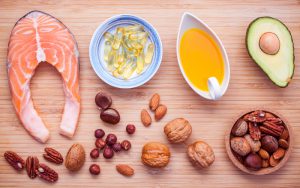 OMEGA 6 is a name for the poly-unsaturated fatty linoleic acid and OMEGA 3 is a name for the poly-unsaturated fatty α linolenic acid. The human body cannot produce these acids and must get it in food. We should take care to have it balanced in our nutrition. These basic fatty acids are processed in the body and new members of omega 3 and 6 fatty acids series are created. The most well-known is the EPA acid and the DHA acid that are also present in fish. The poly-unsaturated fatty acids are an integral part of every human cell; they are an important building element of the cellular membrane which ensures the flexibility and other physical and functional characteristics. Among oils rich in Omega 6 fatty acids that have a beneficial effect on health there is especially olive oil, rapeseed oil, peanut oil, pumpkinseed oil, avocado oil and almond oil. The oils with an excess percentage of Omega 6 fatty acids are the sunflower oil, safflower oil, corn oil, soya oil, cotton oil and peanut oil. We have to note that a surplus of Omega 6 acids in a one-kind oil is less beneficial as far as healthy nutrition is concerned. Healthy Omega 3 fatty acids may be found in a greater volume in linseed oil, low-erucic rapeseed oil, sesame oil, soya oil, evening primrose oil and pumpkinseed oil. Omega 3 a omega 6 have an influence on each other. The balance between them and their balanced ratio is of great importance for a good health. The rapeseed oil has an ideal ratio of Omega 3 and Omega 6 that conforms with dietetic recommendations for a healthy lifestyle and contributes fundamentally to the prevention of cardiovascular diseases.
OMEGA 6 is a name for the poly-unsaturated fatty linoleic acid and OMEGA 3 is a name for the poly-unsaturated fatty α linolenic acid. The human body cannot produce these acids and must get it in food. We should take care to have it balanced in our nutrition. These basic fatty acids are processed in the body and new members of omega 3 and 6 fatty acids series are created. The most well-known is the EPA acid and the DHA acid that are also present in fish. The poly-unsaturated fatty acids are an integral part of every human cell; they are an important building element of the cellular membrane which ensures the flexibility and other physical and functional characteristics. Among oils rich in Omega 6 fatty acids that have a beneficial effect on health there is especially olive oil, rapeseed oil, peanut oil, pumpkinseed oil, avocado oil and almond oil. The oils with an excess percentage of Omega 6 fatty acids are the sunflower oil, safflower oil, corn oil, soya oil, cotton oil and peanut oil. We have to note that a surplus of Omega 6 acids in a one-kind oil is less beneficial as far as healthy nutrition is concerned. Healthy Omega 3 fatty acids may be found in a greater volume in linseed oil, low-erucic rapeseed oil, sesame oil, soya oil, evening primrose oil and pumpkinseed oil. Omega 3 a omega 6 have an influence on each other. The balance between them and their balanced ratio is of great importance for a good health. The rapeseed oil has an ideal ratio of Omega 3 and Omega 6 that conforms with dietetic recommendations for a healthy lifestyle and contributes fundamentally to the prevention of cardiovascular diseases.




